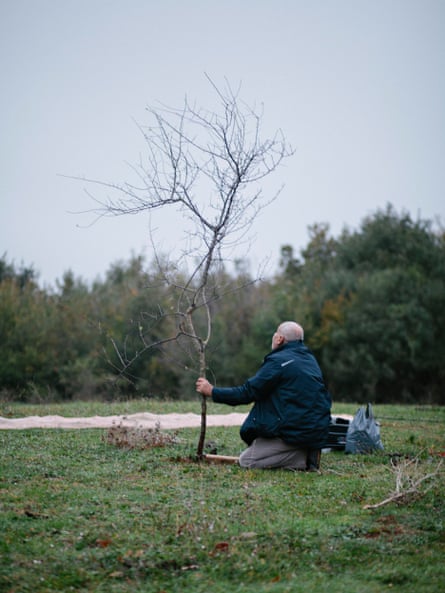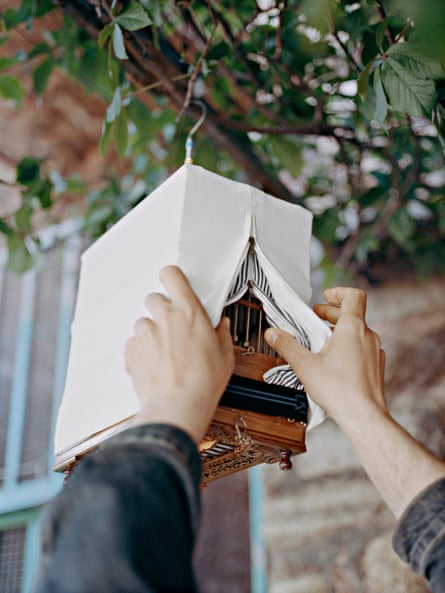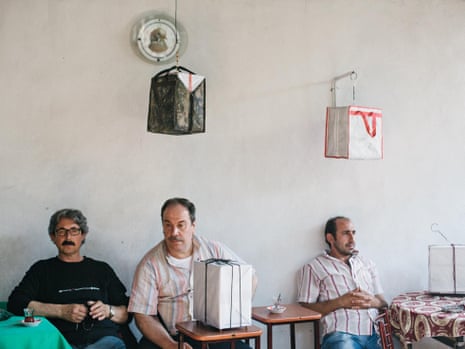For Birds’ Sake, a new, mysterious and poetic book by photographers Cemre Yeşil and Maria Sturm, tells the tale of a secretive and illegal community in Istanbul.
We’re initially introduced to the greenfinch and the goldfinch, long desired and kept in cages for their looks and beautiful song. The story takes a sinister turn with the fate of the male bird, whose song, if concealed from the female during the mating season, “becomes sublime and shows a touch of uncertainty”. So, the male is not only caged but also hidden under fabric and encouraged to sing. The irony is that the listeners are all men.
It’s an old tradition that dates back to the Ottoman empire and now only exists in a handful of hidden cafes in Istanbul. One is pictured almost completely obliterated by ivy, with only a hint of an iron gate to suggest an entrance. Inside are subtle signs that these are bird cafes: hooks on walls, the occasional picture.

The photographers created the project in collaboration, each with a different style: one preferring posed portraits to the other’s looser compositions. But they decided not to credit the images, allowing the project to be a unified piece of work – they learned from each others’ working practices and could question their decisions.
The first challenge was to simply find the bird cafes, and then gain the men’s trust. It is an entirely male world that women would find almost impossible to enter. Over time and by returning again and again, Yeşil and Sturm became friends with the “bird men” – they were taken on bird-catching missions and allowed to photograph singing competitions.
The photographic story begins at night with mysterious views of bushes, brightly lit as if by car headlights. A man sits waiting, contemplating; another looks up at the night sky. As dawn breaks one man is seen digging next to a tree, another hangs nets, and these actions taken out of context seem ritualistic. The most treasured birds are caught in the wild, not bred, apparently because their song is all the more complex when it has been learned naturally.

Our attention is drawn to the inconspicuous details. The single shelf bracket with a loop of wire; a pole that looks like a drip stand (the type hospital patients walk around with) positioned next to a comfortable chair; and of course the small covered boxes, hanging, placed on tables, or carefully held in the hands of their owners. It would be easy not to notice these little boxes – they are very ordinary – but on closer inspection there has been a great deal of attention and care applied to them. Some are made from a hard material with speaker holes drilled into the side, and all have prettily patterned fabric jackets to protect and conceal – details mimicked on the front cover of the book.
A sense of patience connects the images. Throughout, men gaze calmly up at the sky and wait. It is a very quiet book. Apart from a blurry glimpse of feathers, the contents of the boxes are never revealed. Like the men crowding around them, listening attentively, looking at these images produces a heightened awareness of sound.

Even though Yeşil and Sturm spent a lot of time with the bird men and listened to their birds singing, they could never quite hear what the men hear. It takes a well-trained ear to distinguish between songs and be able to hear ones that are truly unique. They try different things to make their birds sing all the more beautifully: tapping and swinging the cages so that in competition their bird will stand out and sing something rare. There is no money in it, only the honour and pride of knowing that they own a bird that has the most beautiful song.
For Birds’ Sake is layered with contradictions. A tattoo on one man’s neck reads: “Don’t touch my freedom”. His explanation: that he kept his bird because it reminded him every day of the importance of freedom.
Yeşil and Sturm have photographed something that is not visible; the reader is forced to use their imagination. And, in a thoroughly masculine community some things seem stereotypically feminine, like the fabric covering the cages.
The photographers admit to feeling bad for the birds, but never let on to the men, and in the end, they say they were witnessing something truly genuine. These men did everything they could to keep the birds happy and well fed, and their love for the birds was like an addiction. Yet they kept them caged.
The book ends with a poem by Cemal Süreya: Life is Short, Birds are Flying. By preventing these birds from flying, their owners might live forever.

Comments (…)
Sign in or create your Guardian account to join the discussion